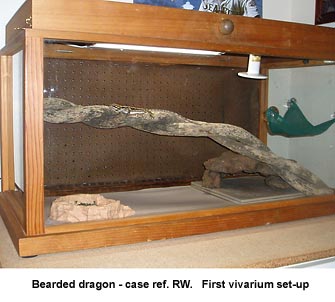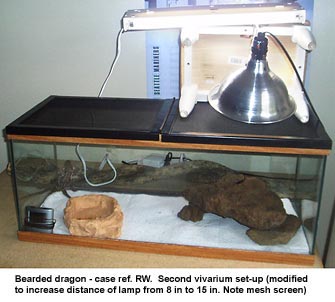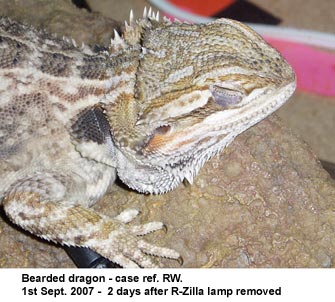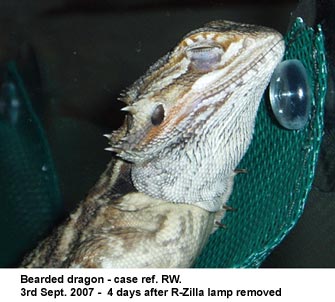|
|
This
is one case from a series of reports compiled as part
of an investigation into photo-kerato-conjunctivitis,
possibly occurring as a result of excessive low-wavelength
UVB radiation under certain brands of fluorescent
UVB lamp.
Please
do not view this one case without reference to the
whole report of which it is a part.
|
Case
History : RW
(Oregon, USA) - Bearded dragon juveniles
(Pogona vitticeps)
 A
healthy, energetic 5-month-old female bearded dragon was
purchased by RW on 12th July 2007 and introduced into a
3ft by 2ft by 2ft wooden vivarium equipped with a ceramic
heater and a new R-Zilla Desert 50 Series T8 15 watt fluorescent
tube at a distance of 7 inches above the basking spot (a
piece of vine wood), inside the vivarium, with no screen
between lamp and reptile. (Figure 1). A
healthy, energetic 5-month-old female bearded dragon was
purchased by RW on 12th July 2007 and introduced into a
3ft by 2ft by 2ft wooden vivarium equipped with a ceramic
heater and a new R-Zilla Desert 50 Series T8 15 watt fluorescent
tube at a distance of 7 inches above the basking spot (a
piece of vine wood), inside the vivarium, with no screen
between lamp and reptile. (Figure 1).
This
was switched on for 12 hours a day, on a timer. Within 24
- 48 hours, the young bearded dragon became lethargic and
began to lie on the floor of the vivarium with its eyes
closed. This was initially thought to be a reaction to her
new home, but over the next few days her condition worsened
and on 16th July she was returned to the breeder and replaced
by a second healthy young female from the same clutch. (Within
2 - 3 days, the breeder reported that the first dragon had
recovered completely.)
Meanwhile,
within 24 hours, the second young dragon began to show similar
symptoms. It had eaten on 17th July, but thereafter refused
food, and continued to deteriorate until 20th July, when
it was first suspected that the R-Zilla lamp might be contributing
to the problem.
The
time for which the lamp was alight was reduced to 5 hours;
then switched off altogether for 2 days. Because there seemed
to be many other reasons why the dragon might have become
ill, RW purchased a completely new, 20-gallon aquarium with
a screen top, estimated by the reptile store to block the
UVB by 40%.
 The
dragon was installed in this new set-up on 21st July, with
the ceramic heater but no UVB. She began to eat again, and
her activity level improved. By 23rd July the dragon was
eating well and active, and the R-Zilla lamp was balanced
on a stool above the screen, at a distance of 15 - 16 in
from the basking spot, for a trial period of one day (12
hours) with no apparent ill effects. (Figure 2.) The
dragon was installed in this new set-up on 21st July, with
the ceramic heater but no UVB. She began to eat again, and
her activity level improved. By 23rd July the dragon was
eating well and active, and the R-Zilla lamp was balanced
on a stool above the screen, at a distance of 15 - 16 in
from the basking spot, for a trial period of one day (12
hours) with no apparent ill effects. (Figure 2.)
On
24th July the lamp was taken off the stool and put on top
of the screen, at a distance of 8 in from the dragon, and
the normal 12-hour lighting pattern resumed. However, the
next day, the dragon stopped eating, and became lethargic
again, sitting with closed eyes; the day after that, she
lay unmoving under the rock shelter all day.
The
lamp was placed back up on the stool, and the dragon showed
a slight improvement over subsequent days. She resumed eating,
but kept both eyes closed at times, particularly her right
eye which seemed more severely affected.
Because
the use of the stool was impractical, RW replaced the R-Zilla
lamp with a brand new 18-inch ZooMed Reptisun 10.0 tube
on 1st August. The bearded dragon recovered completely over
the next few days and thrived for the following month.
However,
on 29th August, assuming that since she was now healthy,
she would probably tolerate a more powerful UVB lamp, and
that this would improve her health still further, RW replaced
the Reptisun 10.0 lamp with the R-Zilla lamp again. That
same day, she retreated to her hide 45 minutes earlier than
usual, and by late afternoon the following day, she was
showing all the previous symptoms - by 5pm, RW wrote, she
had "checked out entirely".
He
removed the R-Zilla lamp completely at that point. With
no UVB, she began to recover, but the process was slow.
She was very lethargic and kept her right eye, in particular,
closed most of the time for four days (Figs. 3 and 4)
The
Reptisun 10.0 lamp was replaced above the screen on 4th
September as her activity levels improved, and was switched
on for very short periods at first, gradually increasing
until 8th September when she seemed to be almost completely
recovered, kept her right eye open all day, and was eating
well. Thereafter, the Reptisun 10.0 was restored to 12 hours
use a day.
RW
took the two lamps to his local specialist reptile store,
where their UVB output was measured. At 7 inches distance,
the R-Zilla lamp gave a reading of about 100µW/cm² and the
Reptisun 10.0 tube gave a reading of about 40 µW/cm².
On
8th September, he shipped the R-Zilla lamp to Frances Baines
for assessment.
|


















 A
healthy, energetic 5-month-old female bearded dragon was
purchased by RW on 12th July 2007 and introduced into a
3ft by 2ft by 2ft wooden vivarium equipped with a ceramic
heater and a new R-Zilla Desert 50 Series T8 15 watt fluorescent
tube at a distance of 7 inches above the basking spot (a
piece of vine wood), inside the vivarium, with no screen
between lamp and reptile. (Figure 1).
A
healthy, energetic 5-month-old female bearded dragon was
purchased by RW on 12th July 2007 and introduced into a
3ft by 2ft by 2ft wooden vivarium equipped with a ceramic
heater and a new R-Zilla Desert 50 Series T8 15 watt fluorescent
tube at a distance of 7 inches above the basking spot (a
piece of vine wood), inside the vivarium, with no screen
between lamp and reptile. (Figure 1).
 The
dragon was installed in this new set-up on 21st July, with
the ceramic heater but no UVB. She began to eat again, and
her activity level improved. By 23rd July the dragon was
eating well and active, and the R-Zilla lamp was balanced
on a stool above the screen, at a distance of 15 - 16 in
from the basking spot, for a trial period of one day (12
hours) with no apparent ill effects. (Figure 2.)
The
dragon was installed in this new set-up on 21st July, with
the ceramic heater but no UVB. She began to eat again, and
her activity level improved. By 23rd July the dragon was
eating well and active, and the R-Zilla lamp was balanced
on a stool above the screen, at a distance of 15 - 16 in
from the basking spot, for a trial period of one day (12
hours) with no apparent ill effects. (Figure 2.)

